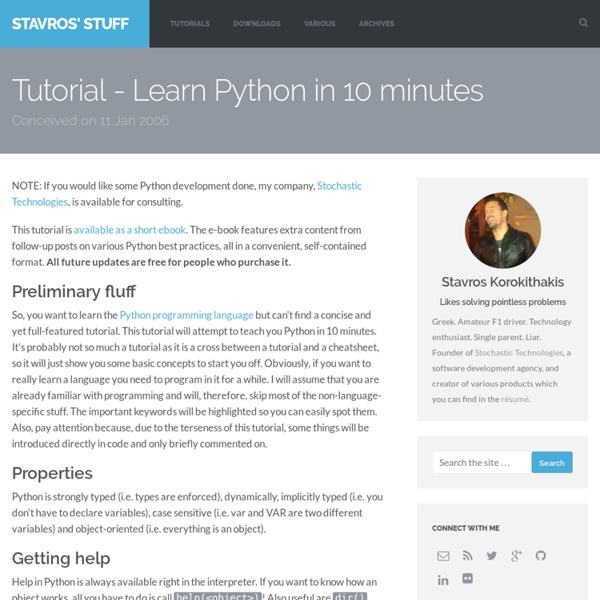Tutorial - Learn Python in 10 minutes

http://www.stavros.io/tutorials/python/
Related: logank1
7 Major Players In Free Online Education
By Jennifer Berry Imagine a world where free, college-level education was available to almost everyone. Believe it or not, you're living in that world right now. Online education has been around for decades, but in the past couple of years, interest has spiked for massive open online courses, otherwise known as MOOCs, according to Brian Whitmer, co-founder of Instructure, an education technology company that created the Canvas Network, a platform for open online courses. "Since 2012, MOOCs have caught the attention of the educational world due to their potential to disrupt how education is delivered and open up access to anyone with an Internet connection," Whitmer explains. According to "Grade Change: Tracking Online Education in the United States," a report by the Babson Survey Research Group released in January 2014, the percent of higher education institutions that currently have a MOOC increased from 2.6 percent to 5.0 percent over the past year.
Arduino Tutorial - Learn electronics and microcontrollers using Arduino!
So, I get two or three emails a day, all basically asking the same thing: "Where can I learn about electronics?" In general, most of these people have seen some of my projects and want to be able to build similar things. Unfortunately, I have never been able to point them to a good site that really takes the reader through a solid introduction to microcontrollers and basic electronics. I designed this tutorial course to accompany the Arduino starter pack sold at the Adafruit webshop. The pack contains all the components you need (minus any tools) for the lessons Follow these lessons for happiness and prosperity.
Python - Notes
You have seen how you can reuse code in your program by defining functions once. What if you wanted to reuse a number of functions in other programs that you write? As you might have guessed, the answer is modules.
Improve website load time by 500% with 3 lines of code
Major New Update - PHP SPEEDY: latest version available here There are 4 relatively easy ways by which you can speed up the time it takes a browser to download a page: Make fewer HTTP requestsAdd a far-future expires headerGzip your page's componentsMinify your JavaScript, CSS and HTML Following on from my post on joining CSS and JavaScript files, I have written a PHP script which will automatically do all of the above. All you have to do is call the following at the top of your page: The code
Computer Networking : Principles, Protocols and Practice
Computer Networking : Principles, Protocols and Practice (aka CNP3) is an ongoing effort to develop an open-source networking textbook that could be used for an in-depth undergraduate or graduate networking courses. The first edition of the textbook used the top-down approach initially proposed by Jim Kurose and Keith Ross for their Computer Networks textbook published by Addison Wesley. CNP3 is distributed under a creative commons license.
Python:Basics:Strings - Python
From Python Strings are variables that hold a contiguous group of characters. Strings in the Real World A string in the real world is a cord, wire, gut, or, well, "string" of some substance that holds together from beginning to end. The term "string" has become so intuitive to us that we use it in other contexts.
The "Invent with Python" Blog
I frequently see a problem when people (especially techies) try to teach programming to someone (especially non-techies). Many programming tutorials begin with basic programming principles: variables, loops, data types. This is both an obvious way to teach programming and almost certainly a wrong way to teach programming. It’s wrong because nobody wants to learn how to program.
The Evolution of a Programmer
High School/Jr.High First year in College program Hello(input, output) begin writeln('Hello World') end. Senior year in College
Related:
python
•
Documentation Référence



